|
Early Anglo-Saxon Clothing
Lesson #2: Page 3
Materials and Techniques:
Weaving.
 Weaving Weaving
In the early Anglo-Saxon period cloth
was woven on upright looms. Weights from warp-weighted looms
are a relatively common find on early settlement sites and show that this
type of loom was used extensively. On the continent there is
evidence for the use of the two-beam loom too. Unfortunately the
two-beam loom leaves little archaeological evidence, and as far as I'm
aware, there is as yet no direct evidence for its use in England, although
it is likely that the two beam loom used.
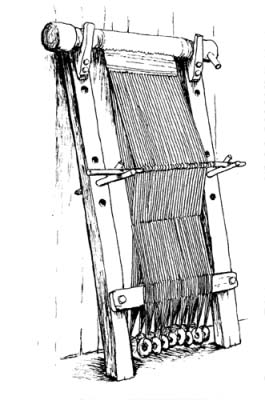 |
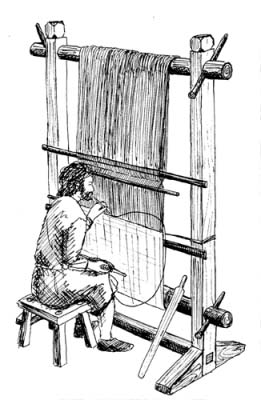 |
|
Warp-weighted loom
|
Two-beam loom
|
Warp Weighted Loom
The commonest type of loom was called
a warp weighted loom. The loom leaned against the wall when
it was in use and could be taken apart for easy storage. Most
families would have probably had a number of warp weighted looms.
The warp threads hung down, and were pulled tight by clay weights.
The two layers of warp threads were held apart by means of a shaft or heddle,
which could be moved, thus giving a shed through which the weft could be
passed. By the use of several heddles quite complicated twills
and herringbones could be woven.
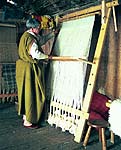 |
Weaving
a simple tabby-weave on a warp-weighted loom.
Click on image for
larger version in new window |
Two Beam Loom
The (presumably) rarer two-beam loom
worked in a similar way to the warp weighted loom, but instead of weights
a bar was used to hold the bottom of the threads taut. Unfortunately
it is hard to tell how widespread this type of loom was since it leaves
little or no archaeological trace. One advantage of the two-beam
looms is it allows cloth to be woven into a tube by wrapping the warp threads
right around both beams of the loom, held in place with a locking bar or
thread. If the thread is left in a tubular piece of cloth is
produced (ideal for a woman's gown). If the thread or bar is
removed a rectangular piece of cloth with four selvedges is produced, ideal
for both women's gowns and cloaks. Several cloaks and gowns
woven on such a loom have been found from the Migration Period in German
and Danish bogs.
Braid Weaving
Narrow braids could be woven using
the technique of tablet-weaving. Tablet weaving is one of the
oldest European textile techniques, traceable at least to the early Iron
Age. The tablets are small flat squares, usually of bone or
wood, with a hole in each corner through which a warp thread is passed.
The tablets are held in the hand like a pack of cards, parallel to the
warp, and turned back or forward by half or quarter turns.
This action twists the four warp threads (controlled by each tablet) into
a cord that can be locked into position by a weft thread inserted between
the turns. By varying the colours of the warp yarn and the
direction of the turn of the tablets, intricate warp patterns can be created.
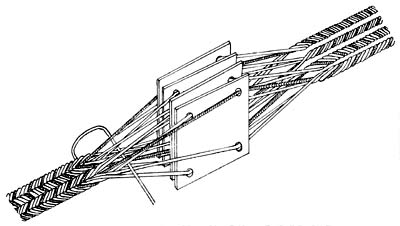 |
|
Tablet weaving
|
Tablet weaving was a very skilled craft.
The bands as they are known in most countries, are often woven with the
finest of wools (sometimes described as cobweb fine). The result is a very
fine piece of work, with woven bands less than10mm wide common and demonstrating
fantastic detail. Original examples have woven names or messages
in the work or rows of animals. The number of patterns possible are almost
limitless, with certain patterns probably typical of particular localities.
Tablet weaving was one of the few occasions that almost anyone could afford
at least some expensively dyed threads that could be included in the work,
in an effort to enhance plainer clothing. In many cases the
tablet woven edge is integral to the garment it is on with the weft of
the tablet weave becoming the warp of the cloth.
Tablet weaving could be further enhanced
by 'brocading'. This brocading was achieved by using a second
weft thread, which ran over some of the warp threads, creating a pattern
on the surface of the thread. Brocaded tablet-weaves were usually
of silk, using gold or silver thread for the brocaded pattern.
This type of braid was a very high status item, and was usually used to
decorate expensive garments.
Another method by which braids could
have been produced is by ordinary weaving. Unfortunately the
pattern variations are not as numerous as in tablet weaving.
Braids have been found made from wool, linen, and silk. Some
have been enhanced by floating (brocaded) gold thread.
These narrow braids could also
be woven on a small vertical loom made for the purpose or on the upright
looms used for weaving wider fabrics. Another alternative is
the backstrap loom. A Backstrap loom would suffice or any variation
upon that to produce complex patterns of band. This would of course leave
very little in the way of archaeological finds, and perhaps answer why
nothing in the way of looms as described have been found. Ethnographic
evidence from the Middle-East prior to WW2 shows ladies weaving bands with
backstrap looms made from little more than sticks. Tablet weave
could also be produced on a horizontal 'tablet loom' - a type well known
from the middle-ages as well as from an 8th-9th century find at Oseberg
in Norway.
 |
Weaving
a simple tablet-weaving loom. Note the second loom to the right
of the picture, and a selection of finished braids behind the weaver.
Click on image for
larger version in new window |
Types of Weave
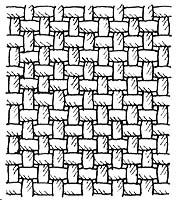
|
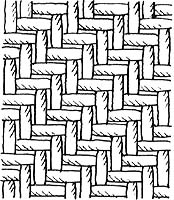
|
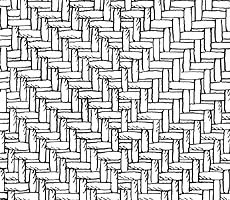
|
|
Tabby Weave
In plain or tabby weave the
weft passes under and over successive single warp threads.
Tabby is de rigueur for linen, although it is also found commonly
for wool. Where the fibres can be identified it seems that
amongst tabby weaves the ratio of linen to wool is approximately 2:1. |
Four-shed (2/2)
Twill
2/2 twill is a distinctive
diagonal weave in which the passage of successive weft threads is staggered
by one warp-thread to the right or the left. Two weave it on
the warp-weigthed or two-beam loom, four seperate sheds had to be opened,
probably by means of three heddle-rods and a moveable shed-rod.
Twill is excellent for creating a strong, stable, hard-wearing fabric and
was used widely for woollen cloth, and occasionally for linen. |
2/2 Twill with
chevron reverses (Herringbone Twill)
Herringbone or chevron twill
is twill weave in which the pattern of diagonal lines is reversed with
a point repeat in one system. In a broken chevron twill (as
in illustration above) the reverse is displaced in one system. |
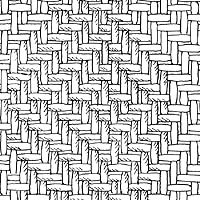
|

|
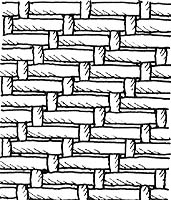
|
|
Broken diamond
twill
2/2 diamond twill is a 2/2
twill in which the weave is reversed in both systems. Like
the chevron/broken twills, diamond twills are found with both point repeat
and with displacement. Normally, the term is used of fabrics
with point repeat, whereas broken diamond twill is used of fabrics
with displacement. As diamond twills with point-repeat are
exceedingly rare in early North European history, the term 'diamond twill'
is often used interchangeably with 'broken diamond twill'.
2/1 diamond twills are also sometimes found, but are much rarer than 2/2
diamond twills. |
Three-shed twill,
2/1 (warp face)
A second twill structure,
2/1 twill, emerged in the north in the first century AD, but it remained
of minor significance, regarded perhaps as a simple pattern-weave.
(If warp and weft are in contrasting colours, each colour dominates one
face of the cloth, i.e. it is reversible.) Roman and Anglo-Saxon
2/1 twills tend to be quite fine; but the Saxons (or maybe the Vikings)
introduced a new fashion for 2/1 diamond (lozenge) twill which became the
principal luxury product of English weavers in the twelfth and thirteenth
centuries. |
Three-shed twill,
1/2 (Weft face)
1/2 twill is much like 2/1
twill, being a three shed twill in which the warp passes over one and under
two wefts. In the small fragments discovered in Anglo-Saxon
burials distinguishing 2/1 twill from 1/2 twill can be difficult. |

|
|
|
|
Tablet weave edge
(See section above for details
of tablet weave) |
|
|
Click on image for larger
version in a new window
Patterns
Patterns in cloth were relatively simple
in Anglo-Saxon times. For example, if the weaver set up a loom
for plain tabby with ten blue warp threads followed by ten yellow with
a blue weft a pattern of blue and greenish stripes would be obtained.
If the weaver varied the weft in the same way as the warp the result would
be a simple three-tone check - squares of yellow, blue and green.
Classical writers tell us that the Iron Age Celts and Germans were fond
of check cloth, and finds from the Danish peat-bogs confirm this.
The check or stripe pattern did not always depend on contrasting dyed or
natural yarns, but sometimes on yarns with contrasted spin directions instead,
giving subtle 'shadow checks' and 'shadow stripes'.
Sometimes a simple effect was to use
a warp of one colour and a weft of another. In tabby weave
this gave the appearance of a third colour (e.g. blue warp and yellow weft
gives a fabric that looks green.) In twills the effect is more
interesting as it gives fine, two-tone diagonal stripes, chevrons or diamonds
depending on which weave it is.
Although there is evidence of such patterns
being used in Anglo-Saxon times, they are rare, most cloth seems to be
quite plain, either dyed a single colour or in some cases undyed.
Naturally pigmented wool (browns and greys) were often used, both in plain
cloths and patterned ones (the latter sometimes in combination with dyed
yarn).
Wool and Linen Cloth
Wool cloth was generally used for outer
garments. Tunics, trousers and women's gowns were generally
of a fine to medium woollen twill (usually around 10-20 threads per cm),
whilst cloaks were generally of medium to heavy wool (usually around 6-12
threads per cm). Mixed spinning, a combination said to make
the cloth wind and thorn proof, was often used for yarns in heavier garments,
particularly for men. Very fine wool tabbies and twills may
also have been used for under-dresses. Many tablet braids,
both patterned and plain, are of fine wool.
Linen tended to be mainly used for under-dresses
and shirts, usually a medium to fine tabby weave (around 15-25 threads
per cm), although a few fine twills are also known. Fine tabby
weave linens (20-60 threads per cm) seem to have been used for head coverings.
Linen cloth seems not to have been dyed. Patterned linen tablet
braids are known from wristbands, and these are the only examples of dyed
linen.
Page
1 | Page 2 | Page 3 | Page
4 | Page 5 | Page
6 | Page 7
Bibliography
|












